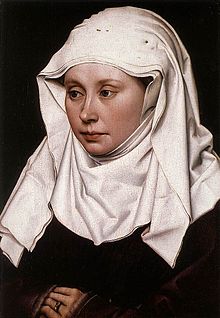
Back Намітка BE Намітка BE-X-OLD উইম্পল Bengali/Bangla Wimpel (Nonne) German Griñón (prenda de vestir) Spanish Buruko oihal EU مقنعه FA Wimple ID Vimplo IO Soggolo Italian


A wimple is a medieval form of female headcovering, formed of a large piece of cloth worn draped around the neck and chin, covering the top of the head; it was usually made from white linen or silk. Its use developed in early medieval Europe; in medieval Christianity it was unseemly for a married woman to show her hair. A wimple might be elaborately starched, creased and folded in prescribed ways. Later elaborate versions were supported on wire or wicker framing, such as the cornette.
Italian women abandoned their head coverings in the 15th century or replaced them with transparent gauze, showing their braids. Elaborate braiding and elaborately laundered clothes demonstrated status, because such grooming was performed by others. Today a plain wimple is worn by the nuns of certain orders who retain a traditional habit.[3]
- ^ Macklin, Herbert Walter; Page-Phillips, John (January 13, 1969). "Monumental brasses". New York, Praeger. Retrieved January 13, 2024 – via Internet Archive.
- ^ Macklin, Herbert Walter & Page-Phillips, John, (Eds.), 1969, p. 69
- ^ Heron, Lynford (January 18, 2003). "Woman, Prayer & Head Covering". Centurion Ministry. Archived from the original on 2010-03-18.